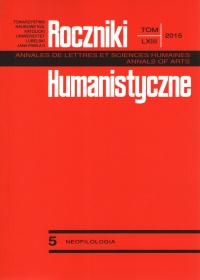Spatial Ontologies of (Neo)Baroque Culture
Abstract
The present article attempts to look at space from the vantage point of neobaroque theory. Its aim is to investigate how such Baroque strategies as framing and de-framing transform surface into space staged within the subject. It also analyzes how breaking the frame of representation may be seen as an ontological act dependent on the body and desire, the act allowing for the aestheticization of reality.
References
Baudrillard, Jean. Symulakry i symulacja. Translated by Sławomir Królak. Warszawa: Wydawnictwo Sic!, 2005.
Calabrese, Omar. Neo-Baroque: A Sign of the Times. Translated by Charles Lambert. Princeton, NJ: Princeton University Press, 1992.
Casey, Edward S. The Fate of Place: A Philosophical History. Berkeley: University of California Press, 1998.
d’Ors. Eugenio. “The Debate on the Baroque in Pontigny.” Translated by Wendy B. Farris. In Baroque New Worlds: Representation, Transculturation, Conterconquest, edited by Lois Parkinson Zamora and Monika Kaup, 78–92. Durham: Duke UP, 2012.
Egginton, William. “Reality is Bleeding. A Brief History of Film from the Sixteenth Century.” Configurations 9 (2001): 207–229.
Egginton, William. The Theater of Truth: The Ideology of (Neo)Baroque Aesthetics. Stanford: Stanford UP, 2010.
Habermas, Jürgen. The Philosophical Discourse of Modernity: Twelve Lectures. Translated by Frederick Lawrence. Cambridge: Polity Press, 1998.
Harries, Karsten. “Space, Place and Ethos: Reflections on the Ethical Function of Architecture.” Artibus et Historiae. 5.9 (1984): 159-165.
Harries, Karsten. The Broken Frame: Three Lectures. Washington, D.C.: Catholic University of America Press, 1990.
Harvey, David. The Condition of Postmodernity: An Enquiry into the Origins of Cultural Change. Cambridge: Blackwell, 1992.
Horkheimer, Max and Theodor W. Adorno. Dialectic of Enlightenment: Philosophical Fragments. Translated by Edmund Jephcott. Stanford: Stanford University Press, 2002.
Jameson, Fredric. Postmodernism, or, The Cultural Logic of Late Capitalism. London: Verso, 1991.
Judovitz, Dalia. The Culture of the Body: Genealogies of Modernity. Ann Arbor: University of Michigan Press, 2001.
Lambert, Gregg. The Return of the Baroque in Modern Culture. New York and London: Continuum, 2004.
Maravall, José Antonio. Culture of the Baroque: Analysis of a Historical Structure. Translated by Terry Cochran. Minneapolis: University of Minnesota Press, 1986.
McHale, Brian. Postmodernist Fiction. London: Routledge, 2004.
Nietzsche, Friedrich. “On the Baroque.” Translated by Monika Kaup. In Baroque New Worlds: Representation, Transculturation, Conterconquest, edited by Lois Parkinson Zamora and Monika Kaup, 44–45. Durham: Duke UP, 2012.
Sarduy, Severo. “Baroque and Neobaroque.” Translated by Christopher Winks. In Baroque New Worlds: Representation, Transculturation, Conterconquest, edited by Lois Parkinson Zamora and Monika Kaup, 270–291.. Durham: Duke UP, 2012.
Sherwin, Richard K. Visualizing Law in the Age of the Digital Baroque: Arabesques and Entanglements. New York: Routledge, 2011.
Stewart, Elizabeth. Catastrophe and Survival: Walter Benjamin and Psychoanalysis. New York: Continuum, 2010.
Wölfflin, Heinrich. Renaissance and Baroque. Translated by Kathrin Simon. Ithaca: Cornell UP, 1990.
Copyright (c) 2015 Roczniki Humanistyczne

This work is licensed under a Creative Commons Attribution-NonCommercial-NoDerivatives 4.0 International License.





